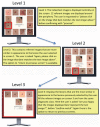Utility of non-rule-based visual matching as a strategy to allow novices to achieve skin lesion diagnosis
- PMID: 21461552
- PMCID: PMC3160473
- DOI: 10.2340/00015555-1049
Utility of non-rule-based visual matching as a strategy to allow novices to achieve skin lesion diagnosis
Abstract
Non-analytical reasoning is thought to play a key role in dermatology diagnosis. Considering its potential importance, surprisingly little work has been done to research whether similar identification processes can be supported in non-experts. We describe here a prototype diagnostic support software, which we have used to examine the ability of medical students (at the beginning and end of a dermatology attachment) and lay volunteers, to diagnose 12 images of common skin lesions. Overall, the non-experts using the software had a diagnostic accuracy of 98% (923/936) compared with 33% for the control group (215/648) (Wilcoxon p < 0.0001). We have demonstrated, within the constraints of a simplified clinical model, that novices' diagnostic scores are significantly increased by the use of a structured image database coupled with matching of index and referent images. The novices achieve this high degree of accuracy without any use of explicit definitions of likeness or rule-based strategies.
Figures


References
-
- Norman G, Eva K, Brooks L, Hamstra S. Expertise in Medicine and Surgery. In: Ericsson KA, Charness N, Feltovich PJ, Hoffman RR, editors. The Cambridge handbook of expertise and expert performance. Cambridge University Press; New York: 2006. pp. 339–354.
-
- Norman GR, Rosenthal D, Brooks LR, Allen SW, Muzzin LJ. The development of expertise in dermatology. Arch Dermatol. 1989;125:1063–1068. - PubMed
-
- Brooks LR, Norman GR, Allen SW. Role of specific similarity in a medical diagnostic task. J Exp Psychol: General. 1991;120:278–287. - PubMed
-
- Norman G, Brooks LR. The non-analytical basis of clinical reasoning. Adv Health Sci Educ Theory Pract. 1997;2:173–184. - PubMed
-
- Norman G, Young M, Brooks L. Non-analytical models of clinical reasoning: the role of experience. Medical Educ. 2007;41:1140–1145. - PubMed
Publication types
MeSH terms
Grants and funding
LinkOut - more resources
Full Text Sources
Medical

